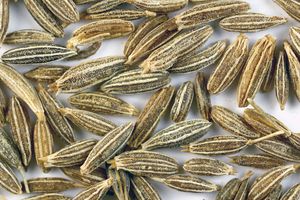Note: This is a project under development. The articles on this wiki are just being initiated and broadly incomplete. You can Help creating new pages.
Difference between revisions of "Cuminum cyminum - Ajaji, Cumin seed"
Chaithrika (talk | contribs) |
Chaithrika (talk | contribs) (+adding internal link) |
||
| Line 5: | Line 5: | ||
'''Cumin'''<ref name="Cumin"/> (Cuminum cyminum) is a flowering plant in the family Apiaceae, native from the east Mediterranean to South Asia. | '''Cumin'''<ref name="Cumin"/> (Cuminum cyminum) is a flowering plant in the family Apiaceae, native from the east Mediterranean to South Asia. | ||
| − | Its seeds (each one contained within a fruit, which is dried) are used in the cuisines of many different cultures, in both whole and ground form. It also has many uses as a | + | Its seeds (each one contained within a fruit, which is dried) are used in the cuisines of many different cultures, in both whole and ground form. It also has many uses as a [[Traditional medicine]] plan. |
Revision as of 17:57, 16 May 2017
"Geerah" redirects here.
Cumin[1] (Cuminum cyminum) is a flowering plant in the family Apiaceae, native from the east Mediterranean to South Asia.
Its seeds (each one contained within a fruit, which is dried) are used in the cuisines of many different cultures, in both whole and ground form. It also has many uses as a Traditional medicine plan.
Contents
USES
Cumin seed is used as a spice for its distinctive flavour and aroma. It is globally popular and an essential flavouring in many cuisines, particularly South Asian (where it is called jeera[citation needed]), Northern African, and Latin American cuisines. Cumin can be found in some cheeses, such as Leyden cheese, and in some traditional breads from France. It is commonly used in traditional Brazilian cuisine. Cumin can be an ingredient in chili powder (often Tex-Mex or Mexican-style), and is found in achiote blends, adobos, sofrito, garam masala, curry powder, and bahaarat. In Myanmar, cumin is used as a spice. In South Asian cooking, it is often combined with coriander seeds in a powdered mixture called dhana jeera.
Cumin can be used ground or as whole seeds. It helps to add an earthy and warming feeling to food, making it a staple in certain stews and soups, as well as spiced gravies such as chili. It is also used as an ingredient in some pickles and pastries.
TRADITIONAL USE
In Sanskrit, cumin is known as jira “that which helps digestion" and is called zira in Persian. In the Ayurvedic system, dried cumin seeds are believed to have medicinal purposes. These seeds are powdered and used in different forms like kashaya (decoction), arishta (fermented decoction), vati (tablet/pills), and processed with ghee (a semifluid clarified butter). It is used internally and sometimes for external applications also.
In southern Indian states, such as Kerala and Tamil Nadu, a popular drink called jira water is made by boiling cumin seeds.
Common name
- English - Cumin seed
- Kannada - ಜೀರಗೆ
- Hindi - Jira
